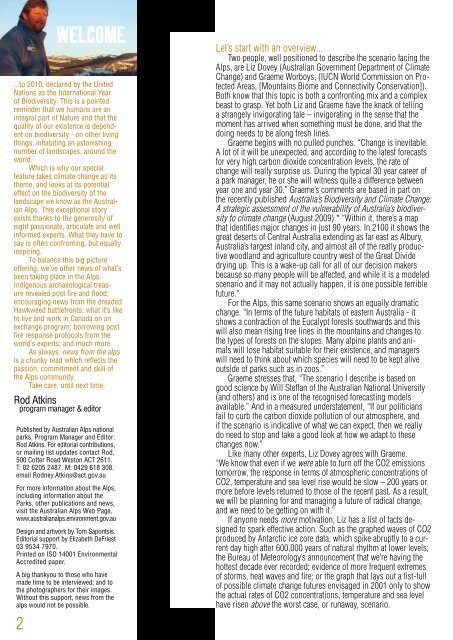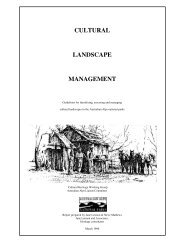Download Newsletter number 39 ( PDF - 980 KB ) - Australian Alps ...
Download Newsletter number 39 ( PDF - 980 KB ) - Australian Alps ...
Download Newsletter number 39 ( PDF - 980 KB ) - Australian Alps ...
You also want an ePaper? Increase the reach of your titles
YUMPU automatically turns print PDFs into web optimized ePapers that Google loves.
WELCOME<br />
...to 2010, declared by the United<br />
Nations as the International Year<br />
of Biodiversity. This is a pointed<br />
reminder that we humans are an<br />
integral part of Nature and that the<br />
quality of our existence is dependent<br />
on biodiversity - on other living<br />
things, inhabiting an astonishing<br />
<strong>number</strong> of landscapes, around the<br />
world.<br />
Which is why our special<br />
feature takes climate change as its<br />
theme, and looks at its potential<br />
effect on the biodiversity of the<br />
landscape we know as the <strong>Australian</strong><br />
<strong>Alps</strong>. This exceptional story<br />
exists thanks to the generosity of<br />
eight passionate, articulate and well<br />
informed experts. What they have to<br />
say is often confronting, but equally<br />
inspiring.<br />
To balance this big picture<br />
offering, we’ve other news of what’s<br />
been taking place in the <strong>Alps</strong>.<br />
Indigenous archaeological treasure<br />
revealed post fire and flood;<br />
encouraging news from the dreaded<br />
Hawkweed battlefronts; what it’s like<br />
to live and work in Canada on an<br />
exchange program; borrowing post<br />
fire response protocols from the<br />
world’s experts; and much more.<br />
As always, news from the alps<br />
is a chunky read which reflects the<br />
passion, commitment and skill of<br />
the <strong>Alps</strong> community.<br />
Take care, until next time.<br />
Rod Atkins<br />
program manager & editor<br />
Published by <strong>Australian</strong> <strong>Alps</strong> national<br />
parks, Program Manager and Editor:<br />
Rod Atkins. For editorial contributions,<br />
or mailing list updates contact Rod,<br />
500 Cotter Road Weston ACT 2611.<br />
T: 02 6205 2487. M: 0429 618 308.<br />
email Rodney.Atkins@act.gov.au<br />
For more information about the <strong>Alps</strong>,<br />
including information about the<br />
Parks, other publications and news,<br />
visit the <strong>Australian</strong> <strong>Alps</strong> Web Page,<br />
www.australianalps.environment.gov.au<br />
www.australianalps.environment.<br />
Design and artwork by Tom Sapontsis.<br />
Editorial support by Elizabeth DeFriest<br />
03 9534 7970.<br />
Printed on ISO 14001 Environmental<br />
Accredited paper.<br />
A big thankyou to those who have<br />
made time to be interviewed; and to<br />
the photographers for their images.<br />
Without this support, news from the<br />
alps would not be possible.<br />
Let’s start with an overview...<br />
Two people, well positioned to describe the scenario facing the<br />
<strong>Alps</strong>, are Liz Dovey (<strong>Australian</strong> Government Department of Climate<br />
Change) and Graeme Worboys, (IUCN World Commission on Protected<br />
Areas, [Mountains Biome and Connectivity Conservation]).<br />
Both know that this topic is both a confronting mix and a complex<br />
beast to grasp. Yet both Liz and Graeme have the knack of telling<br />
a strangely invigorating tale – invigorating in the sense that the<br />
moment has arrived when something must be done, and that the<br />
doing needs to be along fresh lines.<br />
Graeme begins with no pulled punches. “Change is inevitable.<br />
A lot of it will be unexpected, and according to the latest forecasts<br />
for very high carbon dioxide concentration levels, the rate of<br />
change will really surprise us. During the typical 30 year career of<br />
a park manager, he or she will witness quite a difference between<br />
year one and year 30.” Graeme’s comments are based in part on<br />
the recently published Australia’s Biodiversity and Climate Change:<br />
A strategic assessment of the vulnerability of Australia’s biodiversity<br />
to climate change (August 2009).* “Within it, there’s a map<br />
that identifies major changes in just 90 years. In 2100 it shows the<br />
great deserts of Central Australia extending as far east as Albury,<br />
Australia’s largest inland city, and almost all of the really productive<br />
woodland and agriculture country west of the Great Divide<br />
drying up. This is a wake-up call for all of our decision makers<br />
because so many people will be affected, and while it is a modeled<br />
scenario and it may not actually happen, it is one possible terrible<br />
future.”<br />
For the <strong>Alps</strong>, this same scenario shows an equally dramatic<br />
change. “In terms of the future habitats of eastern Australia - it<br />
shows a contraction of the Eucalypt forests southwards and this<br />
will also mean rising tree lines in the mountains and changes to<br />
the types of forests on the slopes. Many alpine plants and animals<br />
will lose habitat suitable for their existence, and managers<br />
will need to think about which species will need to be kept alive<br />
outside of parks such as in zoos.”<br />
Graeme stresses that, “The scenario I describe is based on<br />
good science by Will Steffan of the <strong>Australian</strong> National University<br />
(and others) and is one of the recognised forecasting models<br />
available.” And in a measured understatement, “If our politicians<br />
fail to curb the carbon dioxide pollution of our atmosphere, and<br />
if the scenario is indicative of what we can expect, then we really<br />
do need to stop and take a good look at how we adapt to these<br />
changes now.”<br />
Like many other experts, Liz Dovey agrees with Graeme.<br />
“We know that even if we were able to turn off the CO2 emissions<br />
tomorrow, the response in terms of atmospheric concentrations of<br />
CO2, temperature and sea level rise would be slow – 200 years or<br />
more before levels returned to those of the recent past. As a result,<br />
we will be planning for and managing a future of radical change,<br />
and we need to be getting on with it.”<br />
If anyone needs more motivation, Liz has a list of facts designed<br />
to spark effective action. Such as the graphed waves of CO2<br />
produced by Antarctic ice core data, which spike abruptly to a current<br />
day high after 600,000 years of natural rhythm at lower levels;<br />
the Bureau of Meteorology’s announcement that we’re having the<br />
hottest decade ever recorded; evidence of more frequent extremes<br />
of storms, heat waves and fire; or the graph that lays out a fist-full<br />
of possible climate change futures envisaged in 2001 only to show<br />
the actual rates of CO2 concentrations, temperature and sea level<br />
have risen above the worst case, or runaway, scenario.<br />
We have<br />
caused this<br />
climate<br />
change so<br />
we need to<br />
intervene.<br />
Against this sobering evidence, Liz points out, “While we are<br />
moving into the unknown, this doesn’t mean there is nothing we<br />
can do about it. Obviously business as usual just isn’t going to<br />
work. However the tools we’ve used in the past are still important<br />
and we can build on our strengths.”<br />
Among the strengths we can build on is the collaborative<br />
culture which has been nurtured across the <strong>Alps</strong>. For some time<br />
now we’ve been working together - agency staff, researchers, local<br />
communities, government, and many others - to protect the <strong>Alps</strong><br />
and build this landscape’s resilience to well known threats: fire,<br />
pest species, less water and reduced habitat. While climate change<br />
will affect the <strong>Alps</strong> in unexpected ways, it’s also certain that it will<br />
exacerbate these existing threats and this is why we need to build<br />
on what we already have in place - with some significant changes.<br />
No longer will we be effective in building the <strong>Alps</strong>’ resilience<br />
simply by preserving all species in their current locations, but<br />
rather we need to make space and opportunities for them to self-adapt,<br />
re-organise, move. And we need to continue our efforts to remove<br />
the pest plant and animal species from the picture as this is a stress<br />
and a threat that we can control and minimise (unlike increased fire<br />
or reduced rainfall). We need to press on with connectivity conservation,<br />
again in the interests of space and adaptive movement, and we<br />
should also be poring over maps to help us spot potential refugia<br />
to focus our efforts on – sweet spots where Mother Nature, even<br />
under the influence of climate change, is more likely to be kind to<br />
biodiversity under threat.<br />
And then we get into a more detailed ‘to do’ list: like ecoengineering<br />
(for example, shading bogs to protect them from UV<br />
radiation) or preserving genetic stock (the Ark approach for reintroduction<br />
in the future), and many more. Much of this is already<br />
part of our management approach. However we’re now being strongly<br />
advised, in this uncertain future, to use these tools very differently,<br />
and the new methods hang on a very cozy relationship between the<br />
scientists and the land managers.<br />
Graeme explains. “Suddenly we need all this extra information<br />
about the changes that are happening, and to achieve this we need<br />
a better arrangement for scientists and managers to work together.<br />
The managers need quality information, updated constantly about<br />
what is actually happening so that they can be better informed as<br />
they manage the <strong>Alps</strong>. And the scientists need better collaborative<br />
support and improved long term working and financial arrangements<br />
to be able to do this.”<br />
Both Graeme and Liz appreciate that the biggest shift lies in<br />
how this new relationship operates. As Graeme points out, “We<br />
need to know how well the actions against threats are being carried<br />
out; we need research to give us an improved understanding on<br />
how effective a pest or weed control program is.”<br />
As Liz points out, “We have caused this climate change so<br />
we need to intervene. However to be effective we need to be well<br />
informed. We need to manage adaptively - have a go, test our<br />
theory, monitor its outcomes and then feed that information back to<br />
the start of the decision making loop.” Adaptive management will<br />
be the master methodology, the means by which we chart our path<br />
through the unknown which lies ahead.<br />
This is probably a good moment to take a look at how well<br />
the <strong>Australian</strong> <strong>Alps</strong> are bearing up, through the eyes of a range of<br />
experts in specific fields. Obviously this is just a sample of what’s<br />
happening in many corners across the alpine landscape...<br />
*For more information visit http://www.csiro.au/resources/<br />
Australia-Biodiversity-and-Climate-Change.html<br />
Liz Dovey and Graeme Worboys.<br />
2<br />
3<br />
3

















